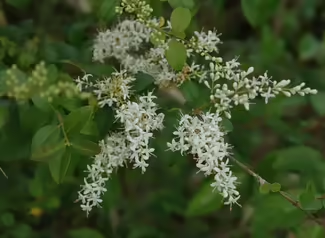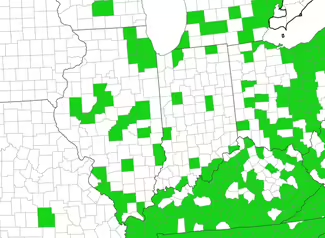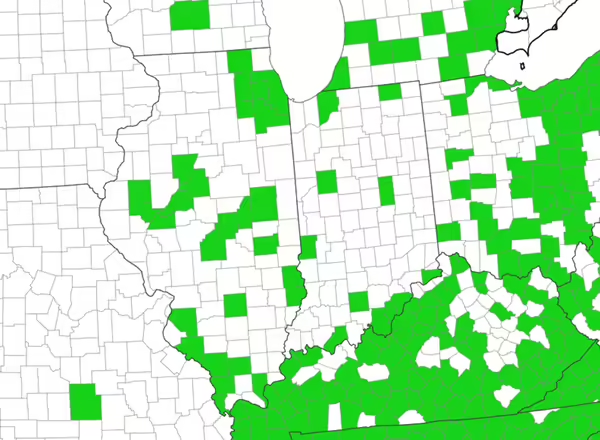
Invasive Privet
Many species of non-native privets (Ligustrum spp.) threaten native plants by forming dense thickets and competing for resources in forest ecosystems. Privet has been used for ornamental hedgerows and privacy screens since the mid-1800s and is still available for purchase.
History of Privets
The various privet species originated from Europe, North Africa, Asia, and Australia and were introduced beginning in the mid-1800s as ornamental plants. They are often touted as ideal for hedgerows and privacy screens due to their dense and semi-evergreen to evergreen foliage. Many of these species and varieties are still for sale today and are promoted by horticulturalists.

Of the species of non-native privet introduced to North America, most are considered invasive species. The most commonly reported privets in Illinois are European privet (Ligustrum vulgare), border privet (Ligustrum obtusifolium), and Chinese privet (Ligustrum sinense). Their impacts vary somewhat between species, but privets generally form dense thickets and outcompete native species. They invade a range of habitats from pastures to woodlands and forests with varying soil and light conditions, including disturbed sites as well as high quality natural areas. Privet invasions may lead to the displacement of native species in forest understories and could slow the regeneration of forests. Some research studies have found the growth and survival of mature canopy trees were negatively impacted in forests with invaded understories.
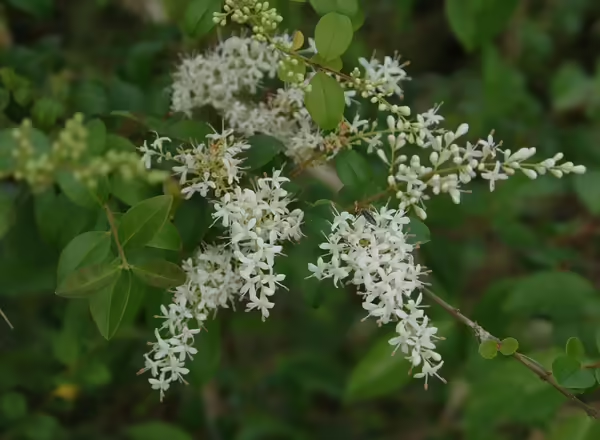
All invasive privet species have simple leaves with entire margins and opposite leaf arrangements. They also have distinctive erect woody stems with grayish bark that are typically around 3-12 feet tall but some species can reach up to 30 feet in height. Privet flowers in the spring, with dense clusters of small, four-petaled white flowers. The flowers are replaced with clusters of blue berries beginning in the summer.
Privet may look like another invasive shrub group, bush honeysuckles (Lonicera spp.) that also have opposite simple leaves with smooth margins. However, bush honeysuckles have hollow stems with tan, stringy bark while privet stems are not hollow and have smooth gray bark. In addition, privet fruits are blue-black while bush honeysuckle fruits are glossy red at maturity.
Illinois does not currently mandate or regulate privets.
- Border privet (L. obtusifolium) is regulated in New York, New Hampshire, Massachusetts, and Maryland and is on invasive species lists in Indiana, West Virginia, Virginia, Pennsylvania, and New Jersey.
- California privet (L. ovalifolium) is listed on invasive species lists in Indiana, New Jersey, and Massachusetts.
- Chinese privet (L. sinense), is regulated in Tennessee, Maryland, and Florida. Chinese privet is also on several state lists of known invasive plants including Indiana, Kentucky, West Virginia, Virginia, Pennsylvania, Alabama, Georgia, and South Carolina.
- European privet (L. vulgare) is regulated in Tennessee, New Hampshire, Maine, and Maryland and is listed as invasive in Oregon, Indiana, South Carolina, West Virginia, Pennsylvania, New Jersey, and Massachusetts.
- Glossy privet (L. lucidum) is regulated in Florida and is on invasive species lists in California, Alabama, Georgia, South Carolina, and Maryland.
- Amur privet (L. amurense) is on invasive species lists in Indiana, South Carolina, and New Jersey.
- Japanese privet (L. japonicum) is regulated in Maryland and is on invasive species lists in Pennsylvania, Alabama, Georgia, and South Carolina.
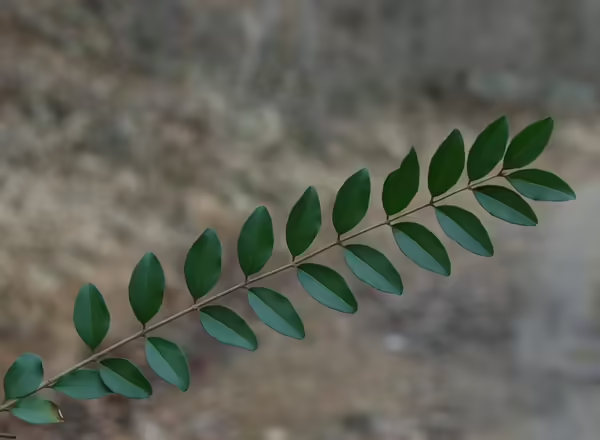
- Mechanical: Small infestations can be mowed or cut to control spread, though this will not eradicate a population. Young seedlings and small saplings can be hand-pulled. Larger plants can be dug or pulled using a grubbing tool. Care should be taken to remove the root crown to prevent sprouting.
- Chemical/Foliar: Apply 2% v/v glyphosate in water or 1% to 2% v/v triclopyr amine in water. Use aquatic-safe formulations when making applications over or near water.
- Basal bark: For plants 6 inches in diameter or less, apply a triclopyr ester formulation at a 20% to 25% v/v rate, mixed with basal oil, to the lowest 15 inches of the stem.
- Cut Stump: Apply triclopyr amine in water or ester in oil at a 20% to 25% v/v rate or glyphosate at a 25% to 50% v/v rate in water within 10 minutes of cutting. Always read and follow the herbicide label before initiating treatment. If seeds are present on the plant, take care not to spread them during control.
For more information, explore Management of Invasive Plants and Pests of Illinois.
- River to River Cooperative Weed Management Area – Fact Sheet – Ligustrum spp.
- National Cooperative Extension – Invasive Species – Ligustrum lucidum
- United States Forest Service – Fire Effects Information System – Ligustrum spp.
- Invasive Plant Atlas of the United States – glossy privet
- EDDMapS – Distribution Maps - Ligustrum
- The ecological effects of Chinese privet (Ligustrum sinense) invasion: a synthesis[SEA1]
- Identification and control of invasive privets (Ligustrum spp.) in the middle southern United States
- Effects of Ligustrum sinense Lour.(Chinese privet) on abundance and diversity of songbirds and native plants in a southeastern nature preserve
